Discover 35 hidden attractions, cool sights, and unusual things to do in Havana (Cuba). Don't miss out on these must-see attractions: Museum of the Revolution, José Martí Memorial, and El Capitolio. Also, be sure to include Morro Castle in your itinerary.
Below, you can find the list of the most amazing places you should visit in Havana (Ciudad de la Habana).
Table of Contents
Museum of the Revolution
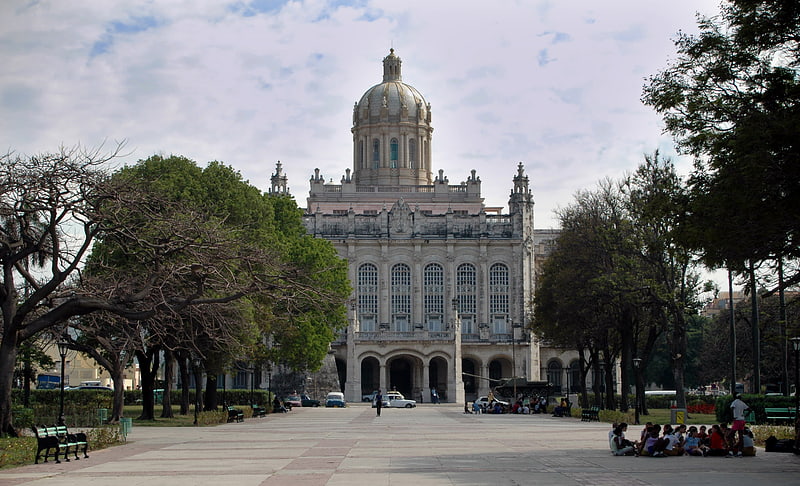
Also known as: Museo de la Revolución
Grand museum with historical exhibits. The Museum of the Revolution is located in the Old Havana section of Havana, Cuba, in what was the Presidential Palace of all Cuban presidents from Mario García Menocal to Fulgencio Batista. The building became the Museum of the Revolution during the years following the Cuban Revolution. The palace building had been attacked by the Directorio Revolucionario Estudiantil in 1957.[1]
Address: Avenida Bélgica, Havana
José Martí Memorial
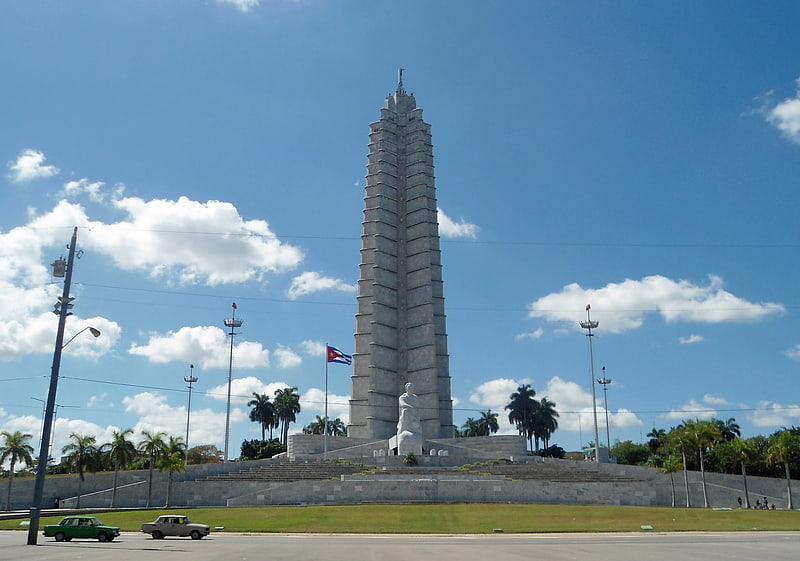
Also known as: Monumento a José Martí
Heritage museum in Havana, Cuba. The José Martí Memorial is a memorial to José Martí, a national hero of Cuba, located on the northern side of the Plaza de la Revolución in the Vedado area of Havana. It consists of a star-shaped tower, a statue of Martí surrounded by six columns, and gardens. It is the largest monument to a writer in the world.
The 109 m (358 ft) tower, designed by a team of architects led by Raoul Otero de Galarraga, is in the form of a five-pointed star, encased in grey Cuban marble from the Isla de Pinos. The design was eventually selected from various entries put forward from a series of competitions beginning in 1939. Entries included a version of the tower topped with a statue of Martí, and a monument similar to the Lincoln Memorial in Washington, D.C. with a statue of Martí seated within. The fourth competition held in 1943 resulted in the selection of a design by the architect Aquiles Maza and the sculptor Juan José Sicre. In order to proceed with construction of the monument, the Monserrat Hermitage, which occupied the proposed site, had to be demolished. Various impediments to the acquisition of the Hermitage by the state led to delays in the demolition and the start of building work, so by 1952 – when Fulgencio Batista seized power in a coup – work on the construction had still not begun.
Eager to garner popular support after seizing power, Batista committed to pushing ahead with the construction of a monument to Martí; but rather than proceeding with the competition winner, he selected the design that had come third in the competition, created by a group of architects headed by Raoul Otero de Galarraga, a 1905 graduate of Harvard University, and included Enrique Luis Varela, Batista's Minister of Works and his personal friend, and Princeton University Professor Jean Labatut. The monument was Raoul Otero de Galarraga's last major architectural and engineering project, and proudest accomplishment. The base was huge and so deep that when looking from above, the men working below-grade looked like miniature men, and rebar was so heavy that six to eight men were required to carry each piece. The concrete, used to fill the base, took several days to pour.
The selection of this design caused something of a public outcry, and as a result the design was modified. The position of the statue of Marti by sculptor Juan José Sicre's statue of atop the tower was moved to tower base. Construction of the tower began in 1953 on the 100th anniversary of José Martí's birth. The marble was delivered to Havana from Isla de Pinos, then cut to the chief architect's specifications, and polished in Gallo's factory. Sicre sculpt the huge stones of marble one at a time. Marti's thoughts were set with gold glass mosaic which came from Venice, Italy, and was personally inspected by Architect and Engineer, Raoul Otero de Galarraga and his son, Raul Otero.
The right to compensation for local inhabitants forced to move to make way for construction caused further problems. The place was known as Catalan Hill (Loma de Los Catalanes) because the Chapel of the Virgin of Montserrat was built there by Catalan immigrants. The Chapel was finally demolished and the monument was completed in 1958 during the final days of the Batista dictatorship.
The selected design includes an enclosed observation deck on the top floor, the highest point in Havana, accessible by elevator which gives commanding views over the city in all directions. (As of August 2016, the observation deck is closed to the public, for replacement of the original elevator.) Housed on the ground floor of the tower which overlooks the city, the memorial features two rooms of correspondence, writings and items from the life of José Martí and displays relating his life story. A third room illustrates the history of the Plaza de la Revolucion, and a fourth room is used for displays of contemporary art. The centre of the tower houses the elevator and features walls decorated with quotes from Martí. Among other items on display is a replica of the sword of Simón Bolívar presented to Fidel Castro by Hugo Chávez during his visit to Cuba in 2002.
Outside, facing over the plaza and towards the mural of Che Guevara on the Ministry of the Interior on the opposite side of the square, is an 18 m (59 ft) white marble statue of Martí carved in situ by Sicre and surrounded by six half-height marble columns. The platform where the statue is located is used as a podium when rallies take place in the Plaza de la Revolución.
Tourists are able to ascend the memorial and enjoy the best panoramic view of Havana. However, many tourists have complained about the ad hoc charges that are administered by the memorial's officials, which varies wildly depending on the members of staff manning the ticket booths. Imposter groundspeople have been known to charge tourists to ascend the memorial steps.[2]
Address: Avenida Paseo, Havana (Plaza de la Revolución)
El Capitolio
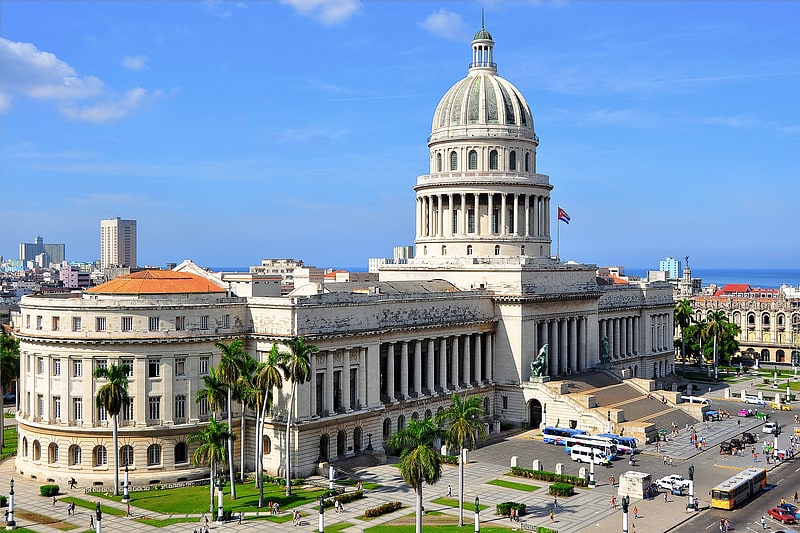
Also known as: Capitolio de La Habana
Edifice in Havana, Cuba. El Capitolio, or the National Capitol Building, is a public edifice in Havana, the capital of Cuba. The building was commissioned by Cuban president Gerardo Machado and built from 1926 to 1929 under the direction of Eugenio Rayneri Piedra. It is located on the Paseo del Prado, Dragones, Industria, and San José streets in the exact center of Havana.[3]
Address: 422 Industria, 10200 La Habana
Morro Castle

Also known as: Castillo de los Tres Reyes Magos del Morro
Sea fortress at the mouth of the harbor. Morro Castle, named after the three biblical Magi, is a fortress guarding the entrance to the Havana harbor. The design is by the Italian engineer Battista Antonelli. Originally under the control of Spain, the fortress was captured by the British in 1762, returned to Spain under the Treaty of Paris a year later. The Morro Castle was the main defense in the Havana harbor until La Cabaña was completed 1774.[4]
Address: Parque Morro, Havana
Finca Vigía

Finca Vigía is a house in San Francisco de Paula Ward in Havana, Cuba which was once the residence of Ernest Hemingway. Like Hemingway's Key West home, it is now a museum. The building was constructed in 1886.[5]
Gran Teatro de La Habana
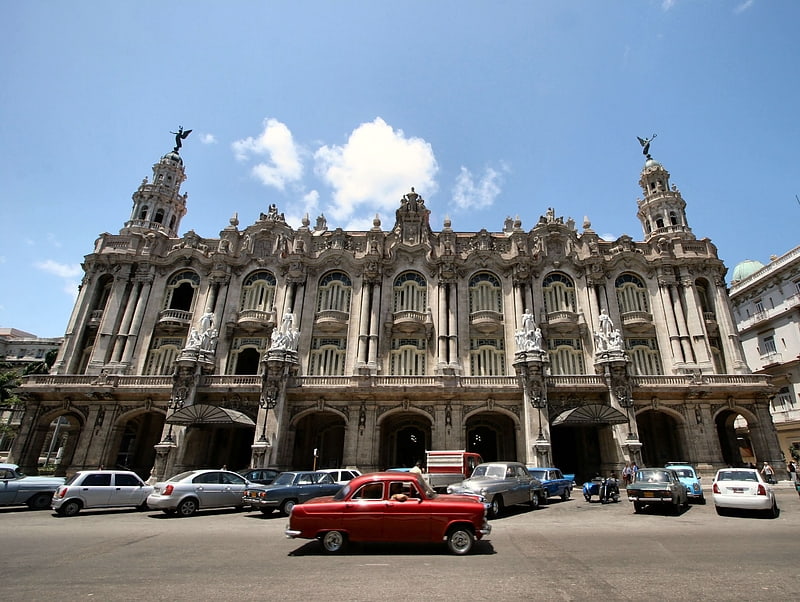
Ornate 19th-century concert hall. Gran Teatro de La Habana is a theater in Havana, Cuba, home to the Cuban National Ballet. It was designed by the Belgian architect Paul Belau and built by Purdy and Henderson, Engineers in 1914 at the site of the former Teatro Tacón. Its construction was paid for by the Galician immigrants of Havana to serve as a their community-social center. Located in the Paseo del Prado, its facilities include theatres, a concert hall, conference rooms, a video screening room, as well as an art gallery, a choral center and several rehearsal halls for dance companies. It hosts the International Ballet Festival of Havana every two years since 1960.[6]
Address: Paseo de Marti 10600, Havana
La Cabaña
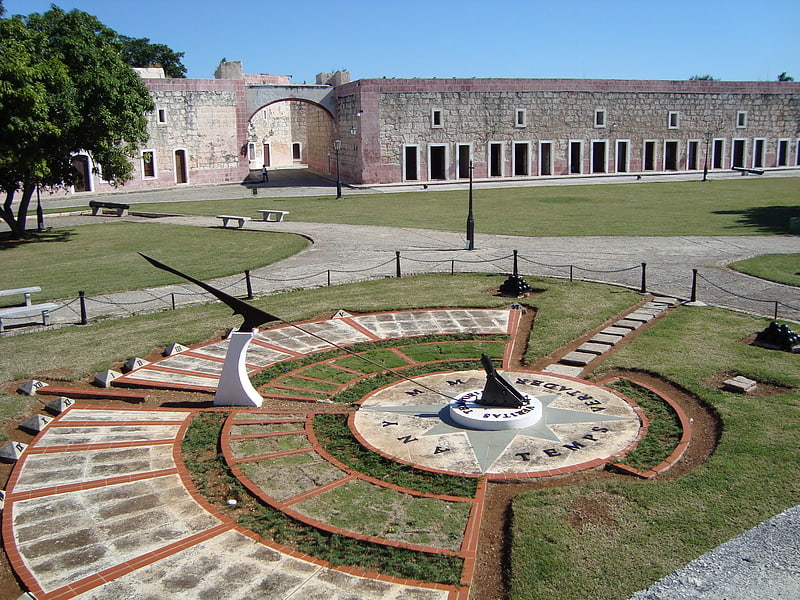
Museum in a restored 18th-century fort. Fortaleza de San Carlos de la Cabaña, colloquially known as La Cabaña, is an 18th-century fortress complex, the third-largest in the Americas, located on the elevated eastern side of the harbor entrance in Havana, Cuba. The fort rises above the 200-foot hilltop, along with Morro Castle. The fort is part of the Old Havana World Heritage Site which was created in 1982.[7]
Havana Cathedral

Also known as: Catedral de La Habana
Baroque-style Catholic cathedral. Havana Cathedral is one of eleven Catholic cathedrals on the island. It is located in the Plaza de la Catedral on Calle Empedrado, between San Ignacio y Mercaderes, Old Havana. The thirty by forty-nine meters rectangular church serves as the seat of the Roman Catholic Archdiocese of San Cristobal de la Habana. Christopher Columbus’ remains were kept in the cathedral between 1796 and 1898 before they were taken to Seville Cathedral.
It was built between 1748 and 1777 and was consecrated in 1782.[8]
Address: Plaza de la Catedral, Havana
Castillo de la Real Fuerza
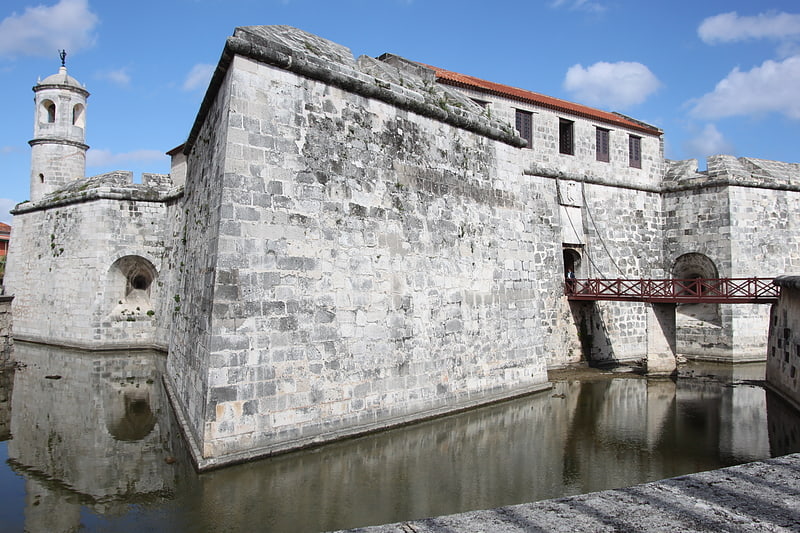
16th-century star-shaped fort and museum. The Castillo de la Real Fuerza is a bastion fort on the western side of the harbour in Havana, Cuba, set back from the entrance, and bordering the Plaza de Armas. Originally built to defend against attack by pirates, it suffered from a poor location; it was too far inside the bay. The fort is considered to be the oldest stone fort in the Americas, and was listed in 1982 as part of the UNESCO World Heritage Site of "Old Havana and its Fortifications".[9]
Address: Plaza de Armas, Havana
Partagas Cigar Factory
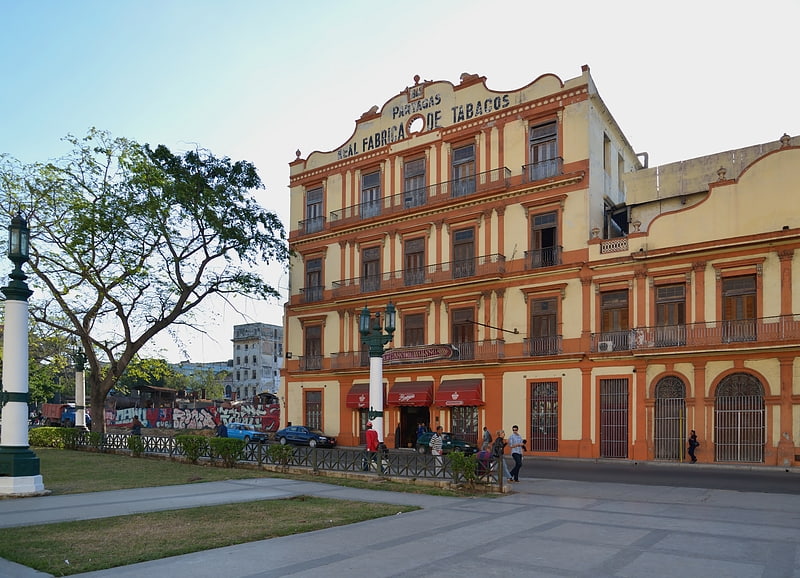
The Real Fabrica de Tabacos Partagás is a cigar factory museum in Havana, Cuba. The world-famous habanos cigars are produced in this factory. Across the street from the massive Capitol building in Havana, is one of Cuba's oldest cigar factories. The Real Fabrica de Tabacos Partagas is housed in a well-preserved industrial building dating from 1845. The building stands out amongst its neighbours because of the ornate colorful maroon and cream exterior. Real Fabrica de Tabacos Partagas was started by Jaime Partagas but foundered after his mysterious death. Ramon Cifuentes took over and the business grew under his stewardship.[10]
Address: Calle Industria 520, Havana
Palacio de los Capitanes Generales
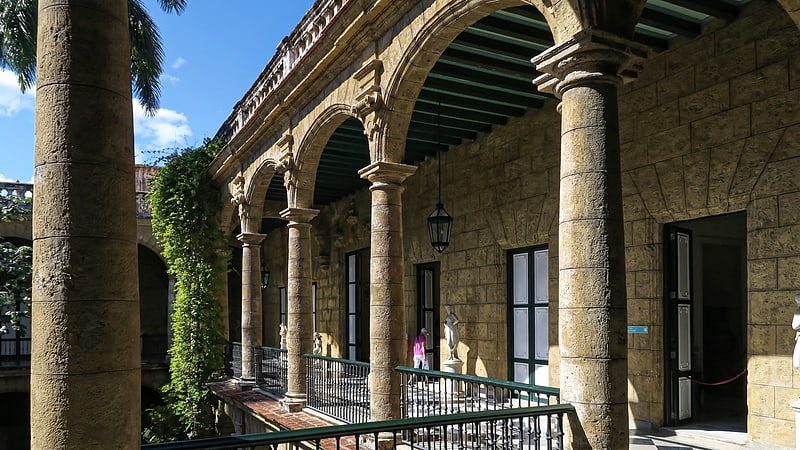
Grand venue for art and historical objects. The Palacio de los Capitanes Generales is the former official residence of the governors of Havana, Cuba. Located on the eastern side of the Plaza de Armas in Old Havana it is home to the Museum of the City of Havana. It houses exhibitions of art and historical artefacts and many of the rooms are preserved with their original Colonial decoration.[11]
Paula

Catholic church in Havana, Cuba. The Iglesia de San Francisco de Paula, Havana is part of the ecclesiastical heritage of Havana. It is located at 110 Calle Leonor Pérez on the corner of Calle San Ignacio. It is near the bay on the south side of Havana Vieja."[12]
Address: Leonor Pérez (Paula), Havana
Colon Cemetery
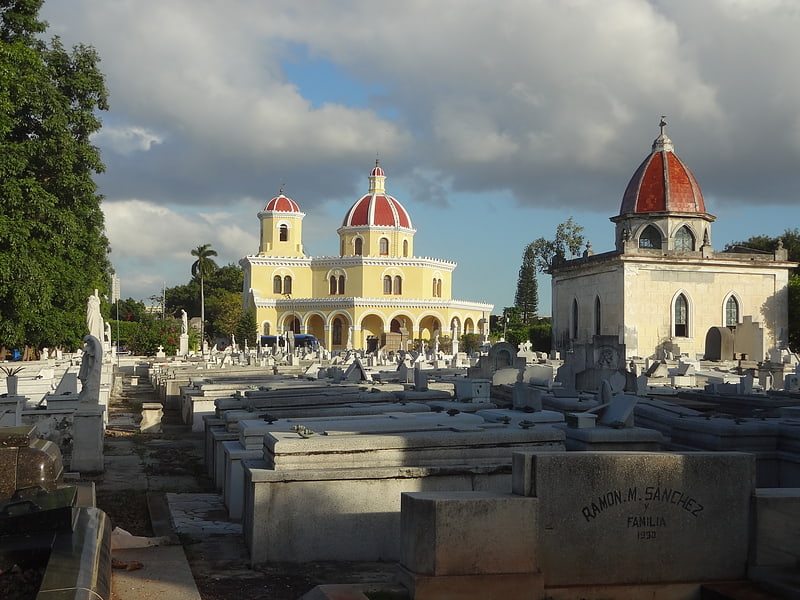
Also known as: Necrópolis de Cristóbal Colón
Landmark cemetery with grand and memorials. El Cementerio de Cristóbal Colón, also called La Necrópolis de Cristóbal Colón, was founded in 1876 in the Vedado neighbourhood of Havana, Cuba to replace the Espada Cemetery in the Barrio de San Lázaro. Named for Christopher Columbus, the cemetery is noted for its many elaborately sculpted memorials. It is estimated the cemetery has more than 500 major mausoleums. Before the Espada Cemetery and the Colon Cemetery were built, interments took place in crypts at the various churches throughout Havana, for example, at the Havana Cathedral or Church Crypts in Havana Vieja.[13]
Address: Calles Zapata and 12, Havana (Plaza de la Revolución)
Basilica Menor de San Francisco de Asis
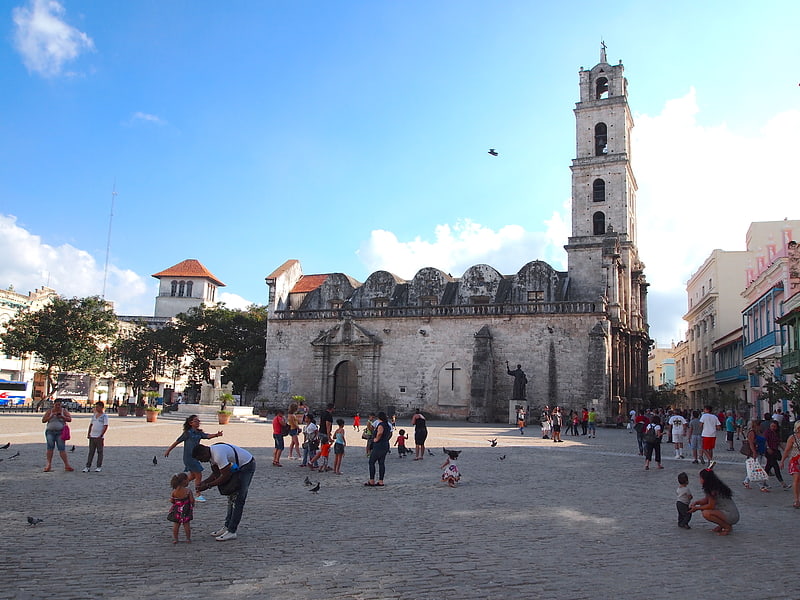
Also known as: Convento de San Francisco de Asís
Historic church turned concert hall. Plaza de San Francisco de Asís (Saint Francis of Assisi Square) is a public square in the district of Old Havana, Havana, Cuba. Founded on 2 June 1628, it is one of the oldest squares in Havana. It is named after the nearby Convento de San Francisco de Asís, a Franciscan convent built between 1575 and 1591. The iconic Fuente de los Leones, built by Italian sculptor Giuseppe Gaggini, was installed in 1836.
In 1761, José Martín Félix de Arrate, Mayor of Havana, considered the Plaza to be the best place in the city. Both the city hall (casas capitulares), police house, jailhouse and customs office faced the Plaza at the time. The Basílica Menor of San Francisco de Asís (Minor Basilica of Saint Francis of Assisi) is a Franciscan convent in the district of Old Havana, Cuba. Its construction began in 1548 and lasted until 1591, although it was inaugurated in 1575, it was damaged by storms in 1680 and 1692, and by a hurricane that broke down its tower in 1694. It began in its current form in 1716, and completed 200 years later with a series of structural reforms from 1731 to 1738.
Painting by Dominic SerresOne of a series of 11 painting completed by Dominic Serres for the Keppel family of the capture of Havana, the last major operation of the Seven Years War, 1756–63. It was part of Great Britain’s offensive against Spain when she entered the war in support of France late in 1761. The British Government’s response was immediately to plan large offensive amphibious operations against Spanish overseas possessions, particularly Havana, the capital of the western dominions and Manila, the capital of the eastern. Havana needed large forces for its capture and early in 1762 ships and troops were dispatched under Admiral Sir George Pocock and General the Earl of Albemarle. The force which descended on Cuba consisted of 22 ships of the line, four 50-gun ships, three 40-gunners, a dozen frigates and a dozen sloops and bomb vessels. In addition there were troopships, storeships, and hospital ships. Pocock took this great fleet of about 180 sail through the dangerous Old Straits of Bahama, from Jamaica, to take Havana by surprise. This painting comes towards the end of the chronological sequence of the series, once Havana has been captured and occupied by the British. The focus of the composition is the magnificent late colonial Baroque architecture of the church of San Francisco de Asís. Despite the received title of the painting, this was not the cathedral of Havana, but a monastic church dating from the 1730s. Serres treats the subject in the conventional manner of a European topographical cityscape, but inserts conspicuous details indicating the context of conflict and the colonial setting. So, red-coated troops exercise in the square, and a sentry stands guard outside his box, across from black-robed figures of Spanish Catholic clerics and alongside a group of self-absorbed boys at play. On the far side of the square another red-coated European strides with his parasol to protect him from the burning tropical sun, while in the harbour beyond the dome of the church sit British warships at anchor.
British occupationThe basilica was used by the British for their worship during the year in which they ruled Havana. The Siege of Havana was a military action that lasted from March to August of 1762, and was a part of the Seven Years' War. British forces besieged and captured the city of Havana, which at the time was an important Spanish naval base, the British dealt a serious blow to the Spanish Navy. Havana was subsequently returned to Spain under the 1763 Treaty of Paris that formally ended the war. When it returned to Spanish rule, they chose not to use it as a church. It is now used for concerts. Attached to the Basilica is a bell tower (138-ft). Originally a statue of St. Francis of Assisi stood on the top of the bell tower but it was destroyed by a cyclone in 1846. Today a statue of Fray Junípero Serra with Juaneño Indian boy stands next to the basilica.[14]
Castillo San Salvador de la Punta
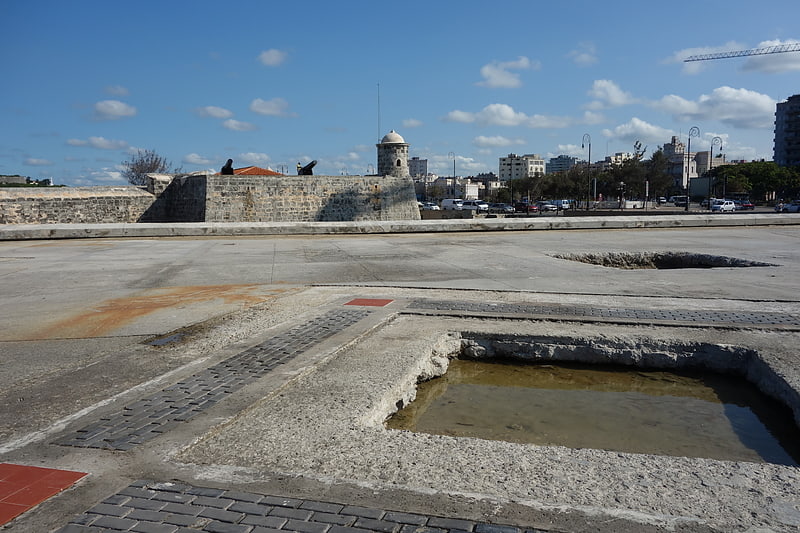
Also known as: Castillo de la Punta
Restored 16th-century harbor fortress. Castillo San Salvador de la Punta is a fortress at the entrance to the bay in Havana, Cuba.[15]
Address: Paseo de Marti Prado y Av. del Puerto, Havana
Iglesia Santo Cristo del Buen Viaje
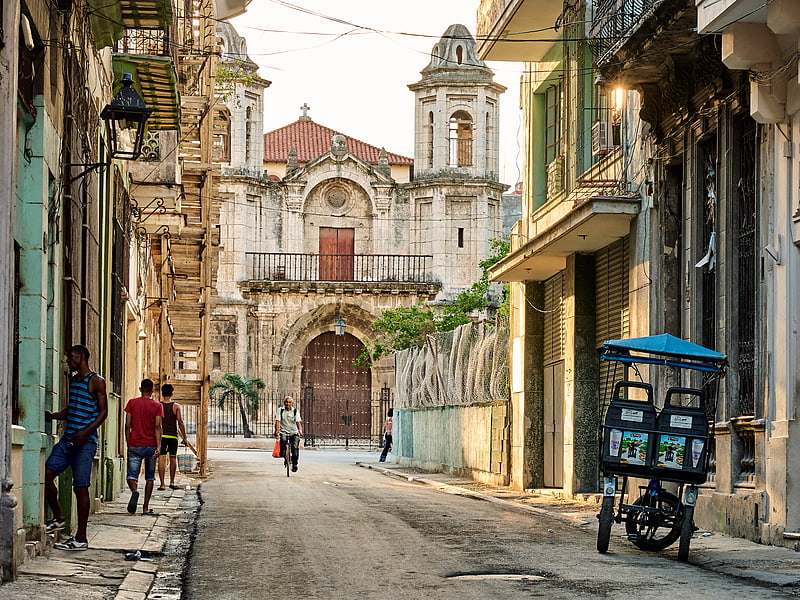
The Iglesia del Santo Cristo del Buen Viaje is located in Havana Vieja on Calle Cristo between Calles Lamparilla y Teniente Rey. Built at a time in which transatlantic crossings were risky, it acquired popularity during colonial times as a temple dedicated to travelers and navigators. Travelers and especially sailors would visit before leaving on a journey, and to pay their respects upon arriving back on land. Later during Cuba's republican era, the devotion to Santa Rita was added to the church.[16]
Museo Nacional de Bellas Artes

Expansive collection of Cuban artworks. The National Museum of Fine Arts of Havana in Havana, Cuba is a museum of Fine Arts that exhibits Cuban art collections from the colonial times up to contemporary generations.[17]
Address: Calle Trocadero e/ Zulueta y Monserrate, Havana
Christ of Havana

Also known as: Cristo de La Habana
Huge statue of Jesus overlooking Havana. The Christ of Havana is a large sculpture representing Jesus of Nazareth, on a hilltop overlooking the bay in Havana, Cuba. It is the work of the Cuban sculptor Jilma Madera, who won the commission for it in 1953.[18]
John Lennon Park

Also known as: Parque John Lennon
Park in Havana, Cuba. John Lennon Park or Parque John Lennon is a public park, located in the Vedado district in Havana, Cuba.[19]
Address: Calle 17, Havana (Plaza de la Revolución)
Parque Lenin
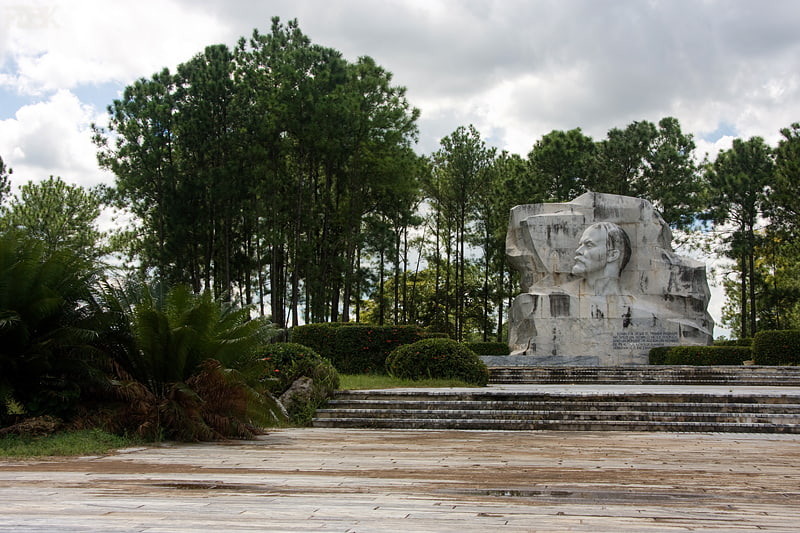
Park in Havana, Cuba. Parque Lenin is a recreational park complex situated south of Havana, Cuba.[20]
Granma Yacht
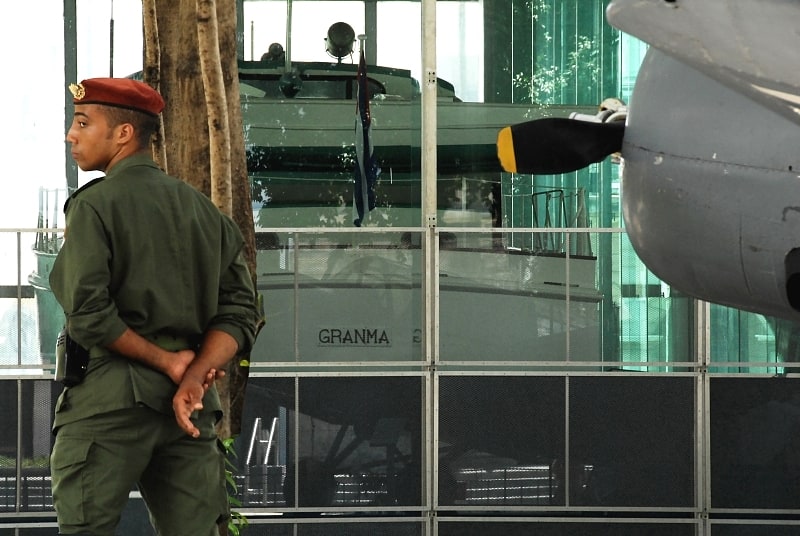
Also known as: Granma
Commemorative site with Castro's boat. Granma is the yacht that was used to transport 82 fighters of the Cuban Revolution from Mexico to Cuba in November 1956 for the purpose of overthrowing the regime of Fulgencio Batista. The 60-foot diesel-powered cabin cruiser was built in 1943 by Wheeler Shipbuilding of Brooklyn, New York, as a light armored target practice boat, US Navy C-1994 and modified postwar to accommodate 12 people. "Granma", in English, is an affectionate term for a grandmother; the yacht is said to have been named for the previous owner's grandmother.[21]
Plaza Vieja
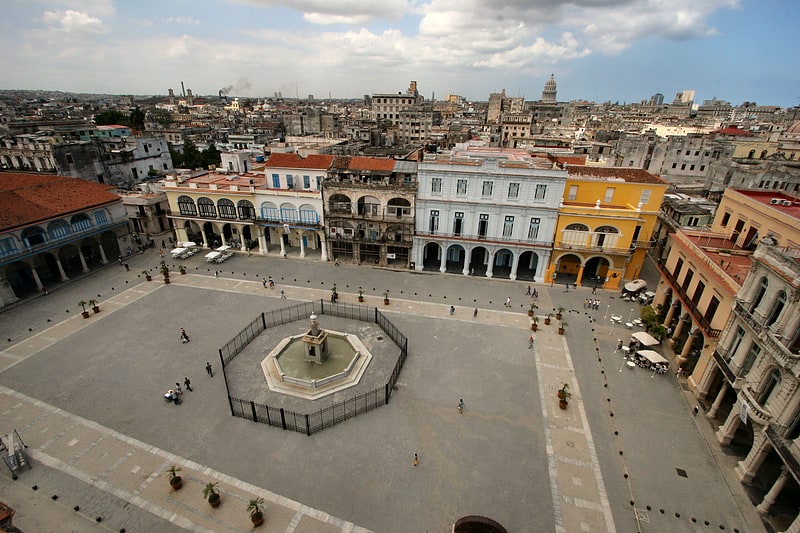
The Plaza Vieja is a plaza located in Old Havana, Cuba. The plaza and its surroundings are also one of the seven consejos populares of the municipality of Old Havana. It has a residential population of 17,426.[22]
Address: La Habana Vieja, Havana
Iglesia de Jesús de Miramar
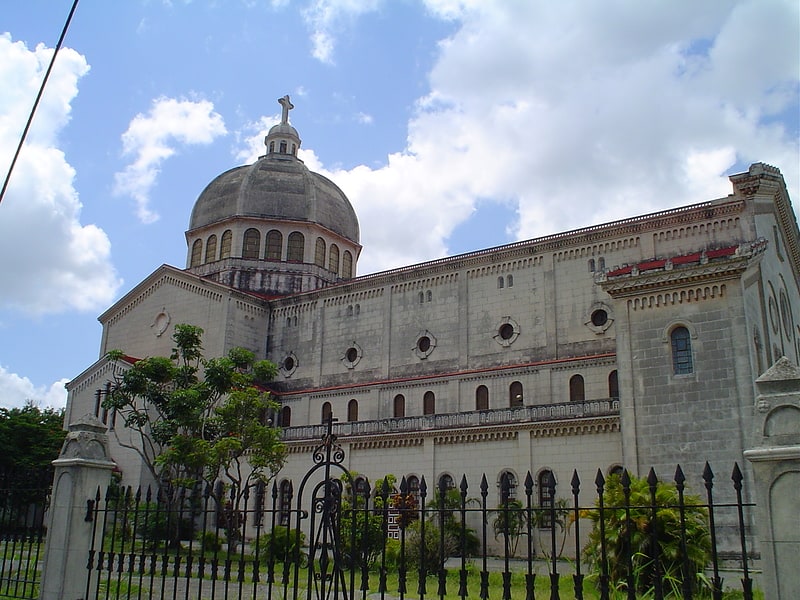
Catholic church in Havana, Cuba. Iglesia de Jesús de Miramar is the second largest church in Cuba. It is located in the Roman Catholic Archdiocese of San Cristobal de la Habana.
It was begun in 1948 and inaugurated on May 28, 1953. It is constructed in the Romanesque-Byzantine style. Its architects were Eugenio Cosculluela (1893–1978) y, Guido Sutter. The church is located at Quinta Ave Esquina an 82 (5th avenue at the corner of 82nd street), Miramar, La Habana, Cuba.[23]
Acuario Nacional
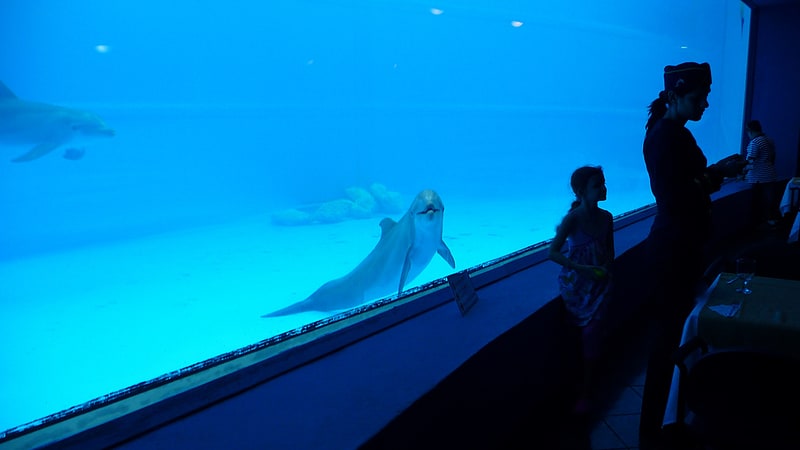
Also known as: Acuario nacional de Cuba
Aquarium in Havana, Cuba. The Acuario Nacional de Cuba is an aquarium in Havana, Cuba established in 1960 to focus on "research and environmental education". Displays include those of coral and other tropical species, as well as a dolphinarium and sea lion shows.[24]
Address: Calle 3ra y 62, 11300 Ciudad de La Habana
Bacardi Building
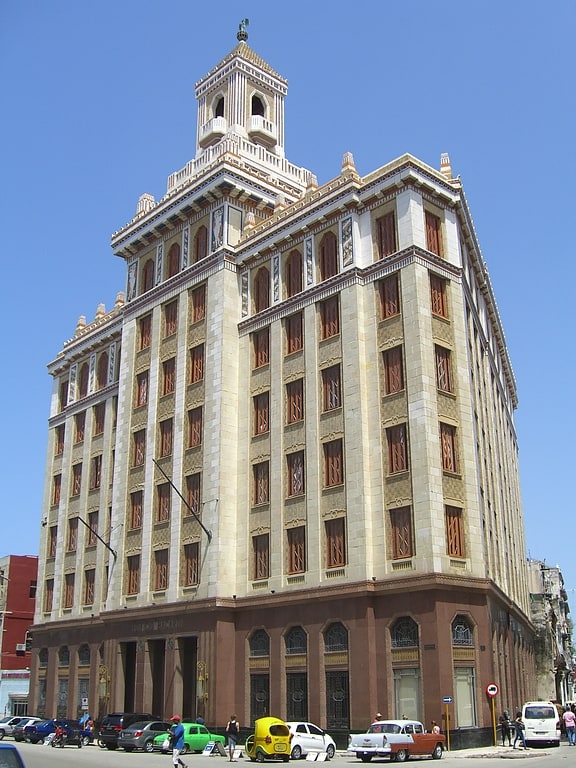
Also known as: Edificio Bacardí
The Bacardi Building is an Art Deco Havana landmark designed by the architects Esteban Rodríguez-Castells and Rafael Fernández Ruenes and completed in 1930. It is located on the corner of Calles Monserrate and San Juan de Dios on a 1,320 sq meter lot in Las Murallas, Old Havana.[25]
Address: Havana, Avenida de Bélgica No. 261
El Templete

Memorial estate in Havana, Cuba. Built in 1827, El Templete commemorates the site of the first mass and town council of San Cristóbal de la Habana celebrated on November 16, 1519.[26]
Address: 12-14 Ave Carlos Manuel Céspedes (Avenue del Puerto), Havana
Our Lady of Kazan Orthodox Cathedral
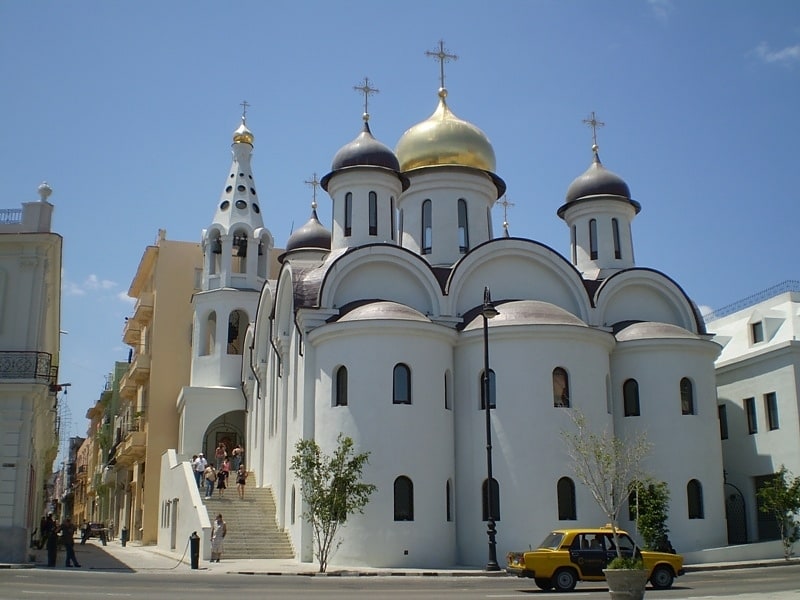
Also known as: Catedral ortodoxa Nuestra Señora de Kazán
Cathedral in Havana, Cuba. The Our Lady of Kazan Orthodox Cathedral, is a Russian Orthodox cathedral located in historic old town of Havana, Cuba, under the jurisdiction of the Russian Orthodox Church.
The temple was built on the shores of Havana Harbour in Old Havana, on the corner of San Pedro Ave. and Santa Clara.[27]
Address: Calle San Pedro 309, Havana
Parque Central
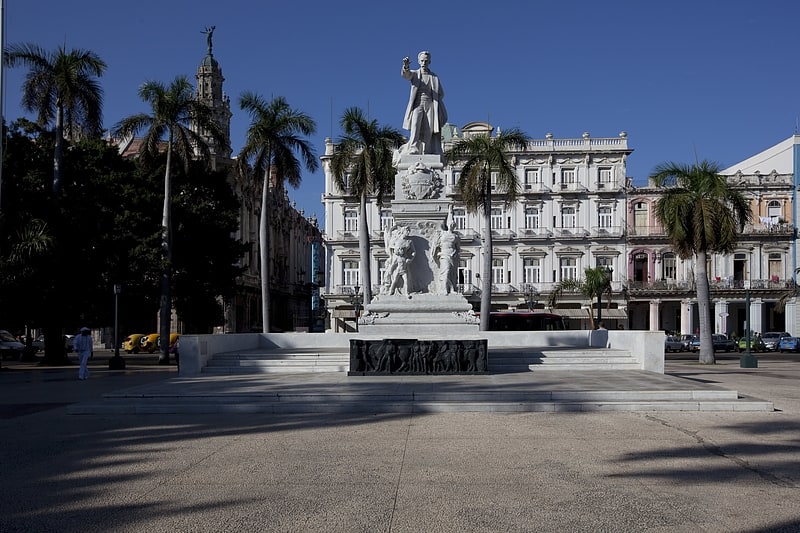
The Parque Central, Havana is one of the best known and central sites of the city of Havana, Cuba. It is located between Prado, Neptuno, Zulueta and San José streets, and San Rafael Boulevard. Among the buildings surrounding the park are Gran Teatro de La Habana, the Hotel Inglaterra, the Hotel Telégrafo, el Hotel Parque Central, la Manzana de Gómez, the Hotel Plaza and Museo Nacional de Bellas Artes.[28]
Address: Paseo de Martí, Havana
National Theatre of Cuba
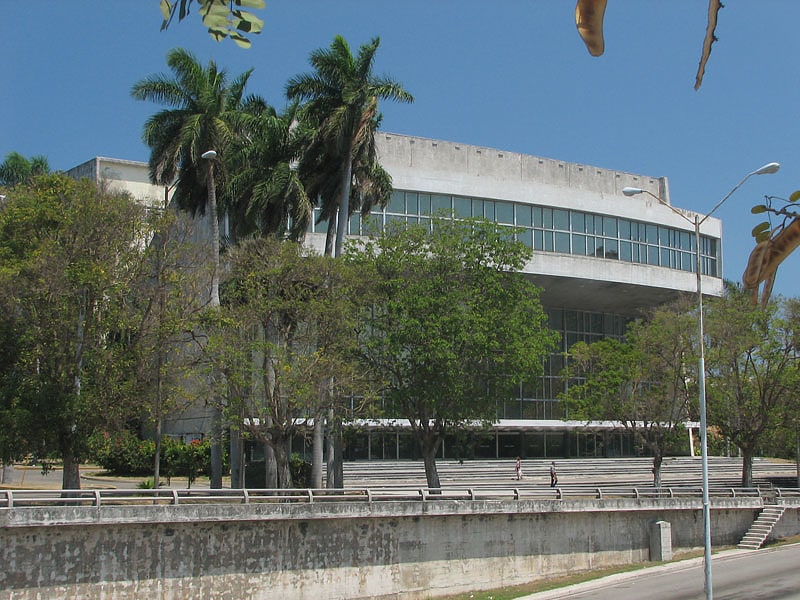
Also known as: Teatro Nacional de Cuba
Theatre in Havana, Cuba. The Teatro Nacional de Cuba is a theatre building in Havana, Cuba, on Plaza de la Revolución.[29]
Address: Paseo & Cl 39, Vedado, Havana (Plaza de la Revolución)
López Serrano Building
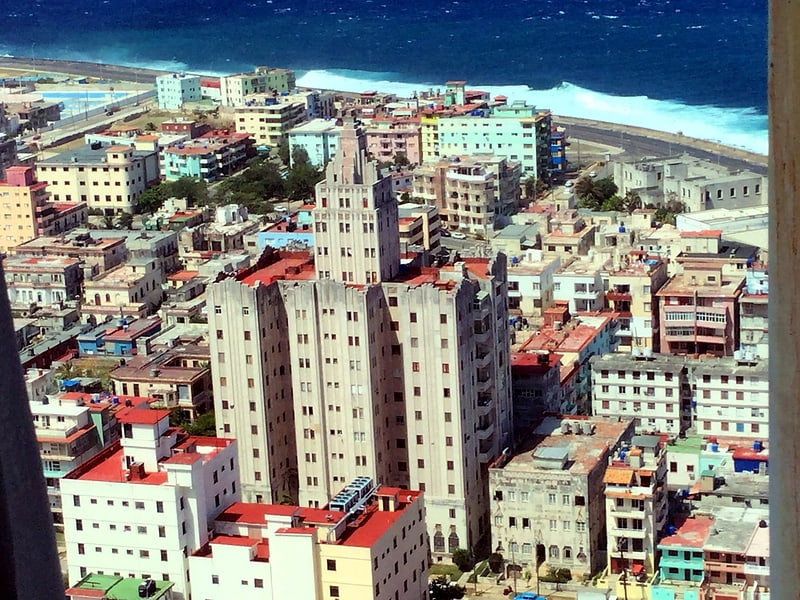
The López Serrano Building was the tallest residential building in Cuba until the construction of the FOCSA in 1956. Designed by the architect Ricardo Mira in 1929, who in 1941 who also designed La Moderna Poesia bookstore on Obispo Street for the same owner, it is often compared to the Bacardi Building in Old Havana built two years before the López Serrano Building because of their similarity in massing and central tower. The congressman, senator, and presidential candidate Eduardo Chibás was living on the fourteenth-floor penthouse when he committed suicide in August 1951 on the air at CMQ Radio Station.[30]
Address: 108 Calle 13, Havana (Plaza de la Revolución)
José Martí
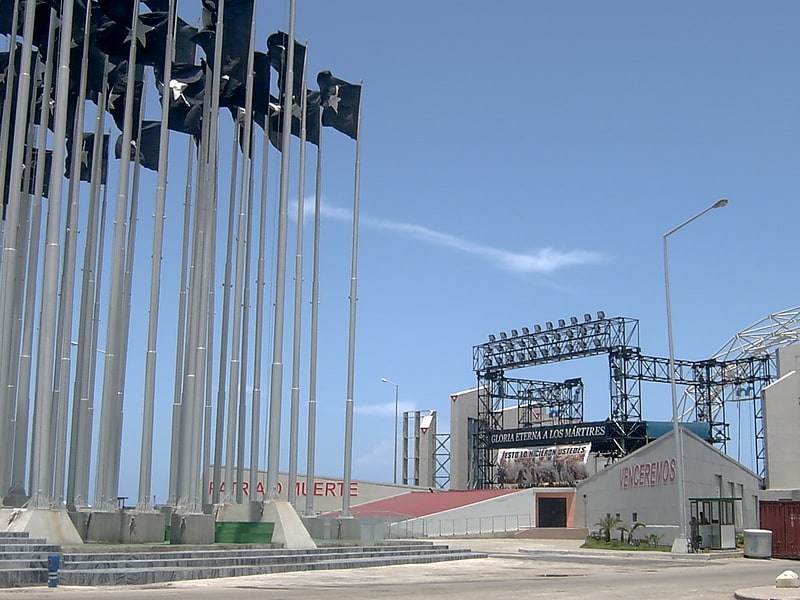
The José Martí Anti-Imperialist Platform is a public event venue located in the Plaza de la Dignidad, across the street from the Embassy of the United States in Havana. It was opened in April 2000.[31]
Espada Cemetery
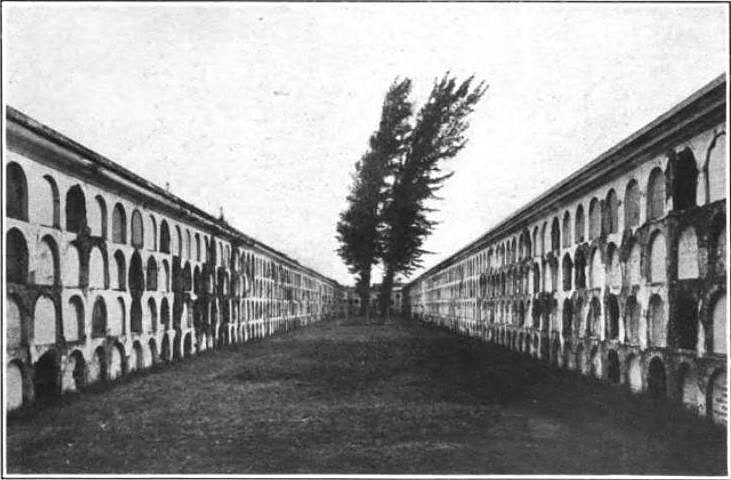
Also known as: Cementerio de Espada
Cemetery. The Espada Cemetery was located in the Barrio of San Lazaro approximately a mile west of the city walls, near the cove of Juan Guillen and close to the San Lázaro Leper Hospital. In use from 1806 to 1878, the Espada Cemetery was the first public burial place designed and constructed in Havana; prior to the cemetery, the Havana custom had been to bury the dead in the vaults of the churches such as Iglesia del Espíritu Santo in Havava Vieja. It was named after the Bishop incumbent at the time of design, José Díaz de Espada y Landa. Its boundaries included the present streets of San Lázaro, Vapor, Espada, and Aramburu. Despite being officially called Campo Santo, the people of Havana referred to the cemetery as el Cementerio de Espada. The cemetery was closed in 1878 and demolished in 1908, only a small wall remains of the original structure.[32]
Cojímar

Town in Cuba. Cojímar is a district in Havana, Cuba, forming a ward that is part of the Habana del Este municipality. Its population is 20,390.[33]
Palace of the Revolution
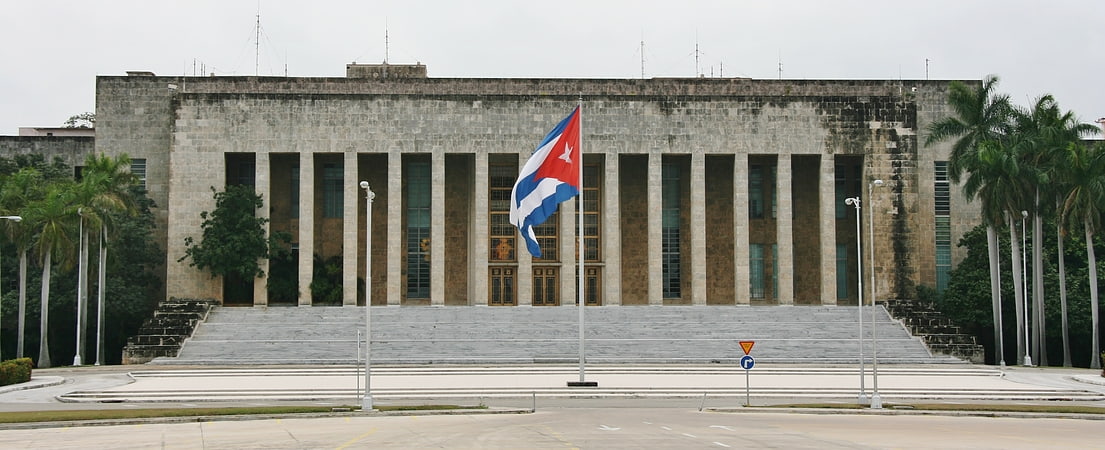
The Palace of the Revolution, is a palace in Havana, Cuba within the Plaza de la Revolución that serves as the house of the Cuban government and the First Secretary of the Cuban Communist Party.[34]
Torreón de la Chorrera

The Torreón de la Chorrera, or to give it its full name, Fuerte de Santa Dorotea de la Luna de la Chorrera, was completed in May 1646. The tower stands on a coral islet only a few metres from the shore and not much larger than the tower itself. The tower's purpose was to impede the entry of enemy ships into the mouth of the Almendares River. The British damaged and captured the tower when they took the city in 1762, after which the tower was rebuilt in its present form. Today, the tower contains a restaurant. In 1982, the Torreón was inscribed on the UNESCO World Heritage List, along with other historic sites in Old Havana, because of the city's importance in the European conquest of the New World, its fortifications, and its unique architecture.[35]